- Clinical Technology
- Adult Immunization
- Hepatology
- Pediatric Immunization
- Screening
- Psychiatry
- Allergy
- Women's Health
- Cardiology
- Pediatrics
- Dermatology
- Endocrinology
- Pain Management
- Gastroenterology
- Infectious Disease
- Obesity Medicine
- Rheumatology
- Nephrology
- Neurology
- Pulmonology
Suturing and Wound Closure, Part 2: Staples, Tissue Adhesive, and Other Methods of Wound Closure
A step-by-step review of various wound closure techniques, illustrated with a wealth of instructive clinical photographs.
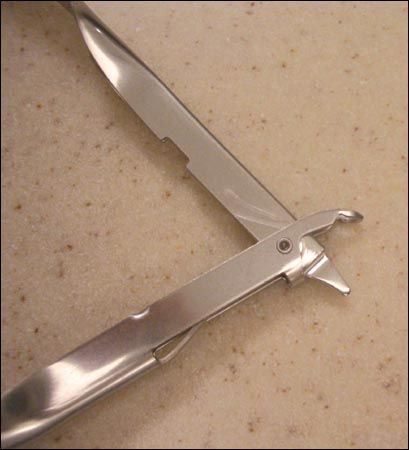
Figure 1 – Use of this special tool facilitates staple removal; however, a small hemostat can also be used.
Most wounds are still closed with some form of needle and thread. However, advances in technology have affected all areas of medicine, even the practice of basic wound closure. In the first installment in this series on wound closure ("Suturing and Wound Closure: How to Achieve Optimal Healing"), I discussed traditional suturing, along with pre-closure issues, such as hemostasis, anesthesia, wound exploration, irrigation, debridement, and preparation of the skin. Here I review a variety of alternatives to suturing that are now available to clinicians: staples, tissue glue, tape, and healing by secondary intention. In the last installment, I will discuss wound care in certain difficult areas, such as the hands, lips, and tongue.
WOUND STAPLES
These are probably the most commonly used alternative to suturing. Wound staples are made of steel and are rectangular, with an opening in the bottom. A variety of products are available. The main advantages of staples, compared with sutures, include increased speed of closure and reduced rate of infection.
Because precise alignment of complex wound edges may be difficult with staples, they are best reserved for linear lacerations in noncosmetic areas. Staples are especially useful on the scalp and other hair-bearing areas. Suturing in such areas can be difficult because the hair hinders the use of a needle driver. Also, the scar that results from wound closure with staples may be slightly worse than the scar from a wound closed with sutures; however, hair will hide the scar after staples are removed from a scalp wound. Because of the risk of a more prominent scar, staples should not be used on the hands or face.
Suggested Equipment for Non-Suture Wound Closure
A disadvantage of staples is that their removal tends to be somewhat more painful than suture removal. Removal of staples usually requires a special tool (Figure 1), although a small hemostat can also be used. Improperly placed staples may require removal at the time of initial closure.
In addition, staples can be difficult to place when there is some separation of the wound edges. This is a common problem with larger scalp wounds. One technique that I find useful when stapling a scalp wound with separated edges is to have an assistant apply inward pressure to the scalp on both sides of the wound and at a distance from it (it is important that the pressure not be applied right next to the wound) (Figure 2). This removes all tension from the wound, easing placement of the staples and allowing for more precise closure.
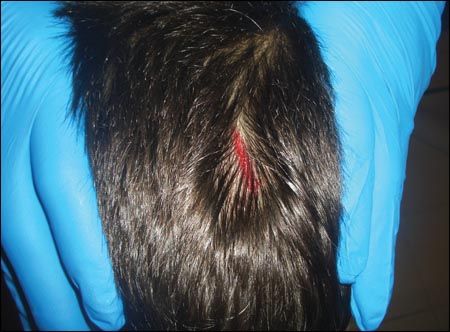
Figure 2 – To remove tension when stapling a scalp wound with separated edges, have an assistant apply inward pressure to the scalp on both sides of the wound. It is important that the pressure be applied at a distance from the wound, not right next to it.
TISSUE ADHESIVE
This alternative to suturing can be used to close small, clean, simple lacerations with no wound tension. Tissue adhesive-also called tissue glue-is an especially attractive method for closing wounds in children, since it tends to be faster and less painful than suturing.
However, tissue adhesive also has significant disadvantages. If, in an attempt to make the procedure painless, the wound is not cleaned properly, the risk of infection may be increased. In addition, the risk of dehiscence is greater in wounds closed with tissue adhesive; thus, a 2-day recheck is required. Contraindications to the use of tissue adhesive include wound tension, complex laceration pattern, a dirty wound, and wound size deeper or longer than 10 cm. Lacerations in areas with excessive hair or in skin creases are relative contraindications.
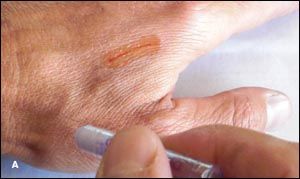
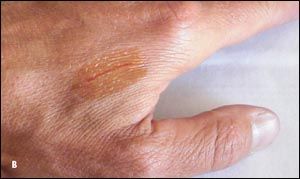
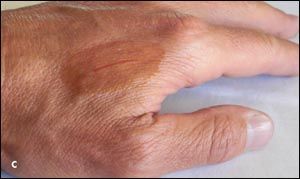
Figure 3 – When using tissue adhesive, apply several successive coats in areas of progressively increasing size (
A
,
B
,
C
); allow about 30 seconds of drying time between coats.
Proper technique is essential when using tissue adhesive. The goal is to build successive layers of adhesive on top of the wound without allowing any to seep into the wound itself (Figure 3). If adhesive actually enters the wound, it may form a barrier between the two wound edges and prevent proper healing. After cleaning the wound but before closing it, it is important to achieve good hemostasis; any oozing of blood or interstitial fluid will either be trapped within the wound or will cause dehiscence in its attempt to drain. Once the wound is dry, crack the ampoule of adhesive and apply it to the wound surface. Apply 4 or 5 successive coats of adhesive in areas of progressively increasing size; allow about 30 seconds of drying time between coats.
A variety of strategies for more controlled application of tissue adhesive have been suggested. One of these is to optimize wound edge apposition by applying outward traction in line with the wound, from the two ends (instead of by pushing in on the edges). In addition, some companies have recently come up with their own improved applicators.
Tissue adhesive usually comes off on its own after 7 to 10 days. Advise patients not to apply antibiotic ointment over tissue adhesive; ointments can lead to premature breakdown of the closure. Also, for obvious reasons, instruct patients not to pick or pull at the adhesive when it eventually starts to fragment. As mentioned previously, a wound check to assess for dehiscence 2 days after closure is mandatory.
One not infrequent acute complication of the use of tissue adhesive is the inadvertent bonding of undesired areas-especially gluing eyelids closed. If undesired adhesion occurs, do not attempt to clean the bond with water; this will speed adhesive hardening. Instead, use antibiotic ointment (ophthalmic ointment when eyelids are involved) to soften the bond. If tissue adhesive is used near the eye, be very careful and position the patient ahead of time so that gravity will direct any drips away from the eye rather than toward it.
STERISTRIPS AND WOUND CLOSURE TAPE
SteriStrips are a slightly more low-tech method for closing lacerations that could also be closed with tissue adhesive; they are probably as effective as tissue adhesive. The strips can be applied fairly easily, are nearly pain-free, and are inexpensive. Their use involves no risk of getting adhesive in the wound; also, if there is a little tension on the wound, this can usually be overcome by placing one end and then pulling across the wound before attaching the other end. In addition, space can be left between strips to allow some drainage if hemostasis is imperfect. The strength of adhesion can be improved by pretreating the wound edges with benzoin or mastic gum adhesive. However, take care not to allow either of these adhesives to enter the wound.
SteriStrips are an excellent choice for small wounds in which suturing might not even be necessary. They are also useful in children because their application can be close to painless.
Wound tape is the closure method of choice for superficial skin flaps in elderly patients; attempting to suture in this setting is usually an exercise in futility because the suture often tears right through the frail skin. Note that wound tape can be used to bolster the edges of wounds in elderly patients that do require suturing. The tape is placed parallel to the wound; then stitches are placed through it to reduce the risk of the suture slicing through frail tissue.
HEALING BY SECONDARY INTENTION
Many wounds are small enough or superficial enough that they do not require closure. Allowing a wound to heal "as is" is an especially tempting option for small lacerations in children or for any laceration in a hard-to-reach area, such as within the mouth or on the tongue. In general, wounds smaller than 1 to 2 cm usually heal well without suturing as long as the edges come together well on their own.
NON-SUTURE WOUND CLOSURE: PITFALLS & PEARLS









References:
FOR MORE INFORMATION:
■ Hollander JE, Singer AJ. Laceration management.
Ann Emerg Med
. 1999;34:356-367.
■ Pregerson DB.
Quick Essentials: Emergency Medicine
. 2nd ed. Carlsbad, CA: ERPocketBooks.com; 2006.
■ Pregerson DB.
Cornucopia: Emergency Medicine
. Carlsbad, CA: EMresource.org; 2008.
■ Schaider J, Hayden SR.
Rosen & Barkin's 5-Minute Emergency Medicine Consult
. 2nd ed. Philadelphia: Lippincott Williams & Wilkins; 1999.
■ Tintinalli JE, Kelen GD, Stapczynski JS, eds.
Emergency Medicine: A Comprehensive Study Guide
. 6th ed. McGraw-Hill; 2003.
